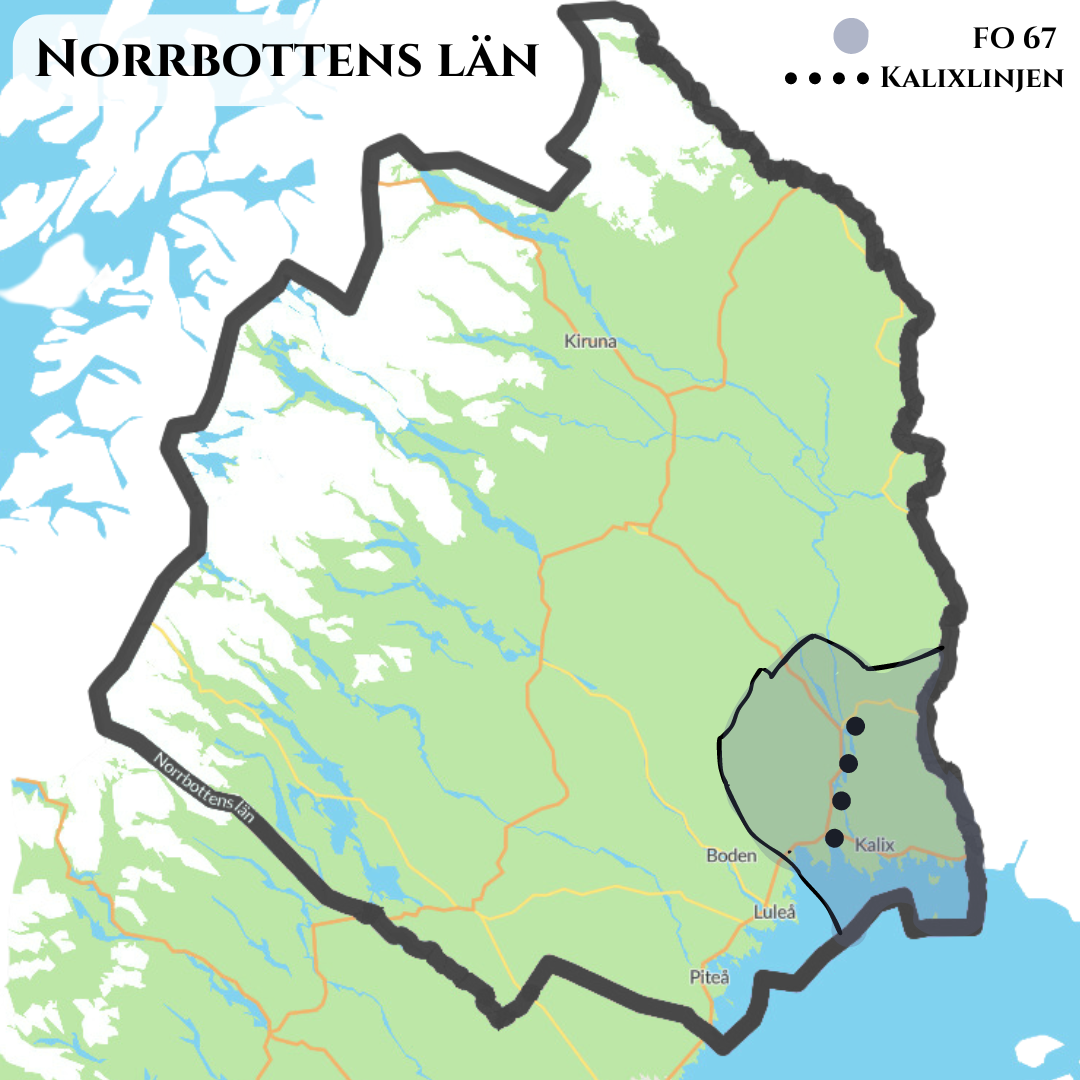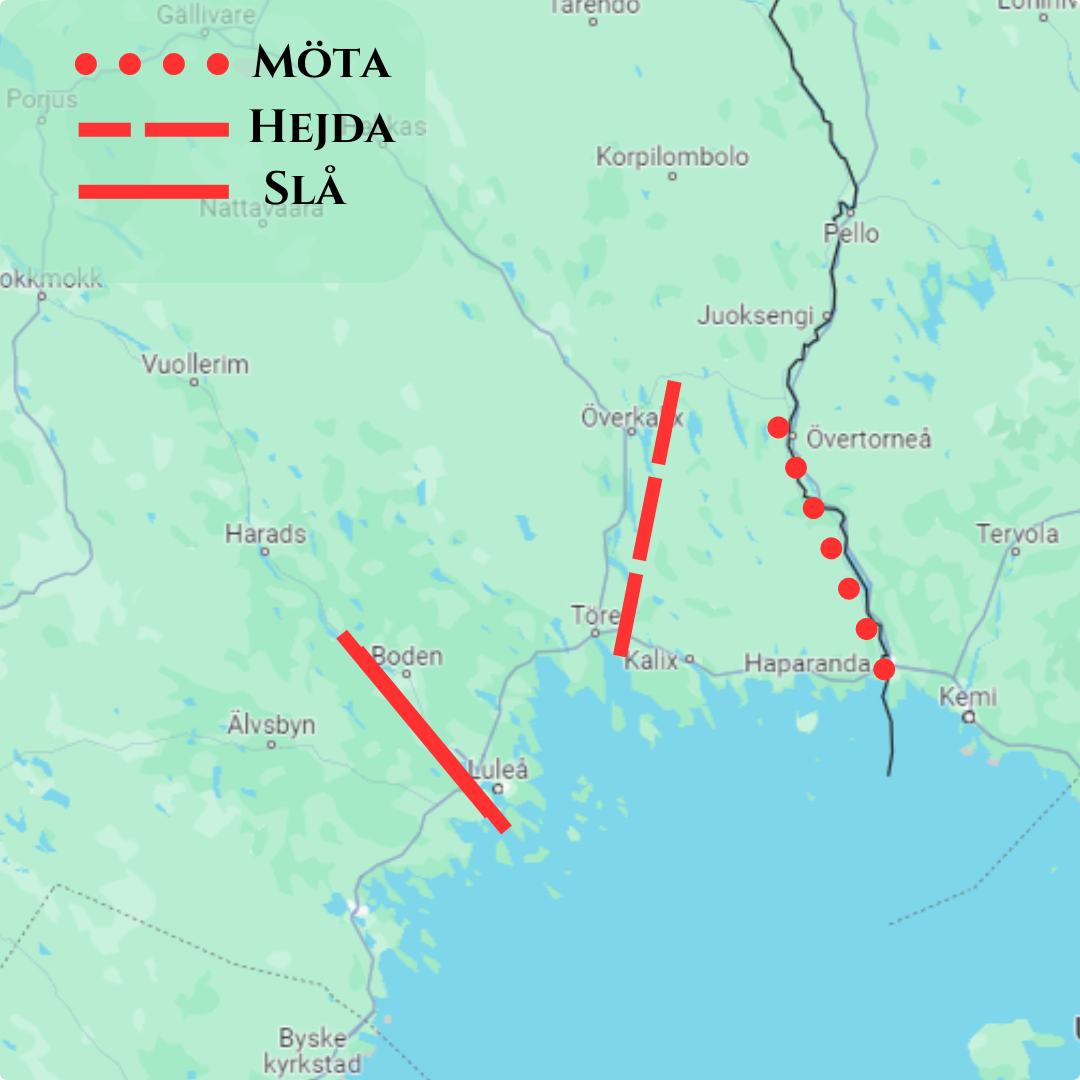The Kalix line
The Kalix line was a defense zone near the Finnish border and one of Sweden's most important military defense lines during the Cold War. Construction began during World War II, and during its active period (circa 1939–1995), the Soviet Union was the primary threat.
Sweden prepared meticulously for a potential invasion.
The secrecy and security surrounding the military installations and defense plans were immense, as Kalixlinjen was one of the most strategically important military areas in Sweden.
The defense line consisted of both fixed and mobile defense systems and held strategic importance for protecting Sweden, including the crucial harbors in the Gulf of Bothnia.
The defense line was part of Sweden's preparedness, and a significant portion of the country's civilian and military resources were dedicated to maintaining it.

Norrbotten.
Defense Area 67 shaded. Kalixlinjen dotted.
Meet - delay - beat
The strategy behind Kalixlinjen was not primarily to stop a Soviet invasion directly at the border, but rather to follow the principle of Meet - Delay - Defeat..
Meet - Even before the Soviets crossed the Torneå River, they would be met with resistance.
The Home Guard in the area had the authority to blow up the bridges over the Torneå River if they saw the threat approaching. Fixed gun batteries in Parviainen and Miekojärvi could fire heavy anti-tank shots deep into Finnish territory, preventing a rapid advance of the enemy.
Delay – The enemy's path into Sweden would be slow and difficult!
The roads were prepared to be mined and blown up, and hundreds of thousands of obstacles were placed in the forests. 2,800 fortifications at strategic positions would provide protection for the Swedes to counter the enemy's attempts to repair the roads.
The fixed battery at Kamlunge/Häggmansberget was tasked with firing over Raggdynan/E4 to prevent easy access. Siknäsfortet had even greater firepower and could blow up the bridges over the Kalix River if necessary. Siknäsfortet was also responsible for protecting the northernmost deep harbor of the Gulf of Bothnia (Törehamn) and providing armored fire over the E4. Both Siknäsfortet and the battery at Kamlunge/Häggmansberget is still intact and can be visited by the public.
Defeat – The Fortress of Boden has been called the "lock of the north."
Boden was the most impressive fortress in Kalixlinjen, built on and within several mountains around Boden. Its size, firepower, and complexity have no equivalents in the Nordic region. Here, Sweden would stand against the enemy that had managed to cross the border and overcome all obstacles in Kalixlinjen. Rödbergsfortet, which was part of the Boden Fortress, is still intact and open for visits.
The Swedish defense strategy in Kalixlinjen was not only focused on stopping a potential invasion but also on preventing the Soviets from reaching the Norwegian coast and the important deep-water harbors that led out to the Atlantic.

Overview Meet - Delay - Defeat
The entire area up to the fortress of Boden was prepared for resistance.

Kanonbatterier inom FO 67.
Fortifications and Infrastructure
Kalixlinjen consisted of a series of fortifications and forts, such as Rödbergsfortet and Siknäsfortet, along with a series of cannon batteries and radar stations. In addition to the fixed defense stations, there were also more mobile units that could be deployed if the situation required.
Kalixlinjen was one of Sweden's most well-equipped and secretive defense zones during the Cold War, encompassing both heavy artillery defense and a sophisticated network of intelligence and surveillance.
Sweden's Preparedness and Civil Defense
In addition to the military installations and fortifications, there was also a strong civil preparedness in Norrbotten and other parts of Sweden. The Home Guard played a central role in the defense of Kalixlinjen, responsible for quickly mobilizing and defending key bridges and roadblocks in the difficult-to-access terrain.
Disbandment and After the Cold War
After the Cold War ended and the Soviet Union collapsed, the dismantling of Kalixlinjen began in the mid-1990s. Most of the fortifications and installations were dug up, filled in, abandoned, or sold off.
Some of them are still preserved and accessible to the public as museums.
Kalixlinjen was an important part of Sweden's Cold War defense, and many of the buildings and installations that remain offer a unique insight into the military preparedness during this period.